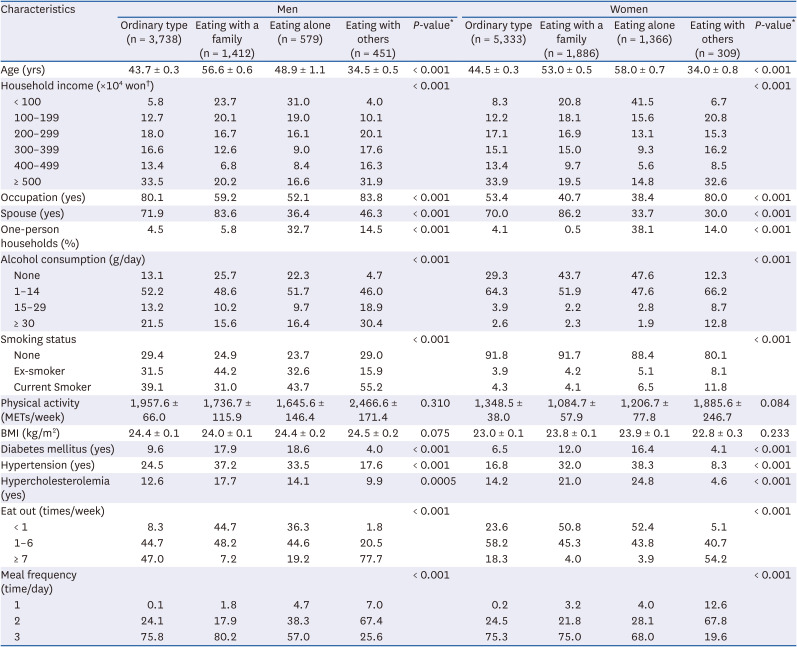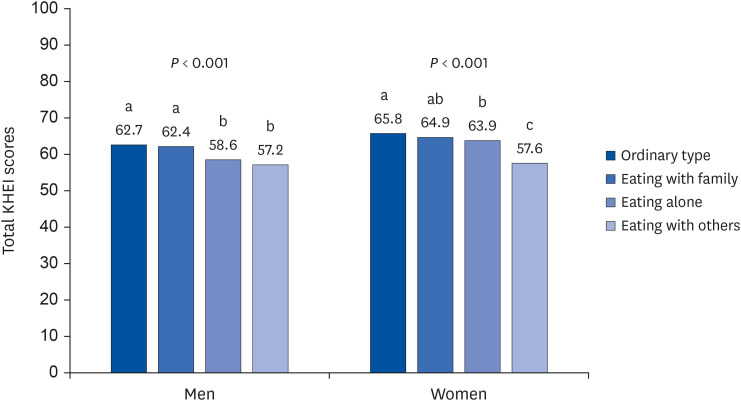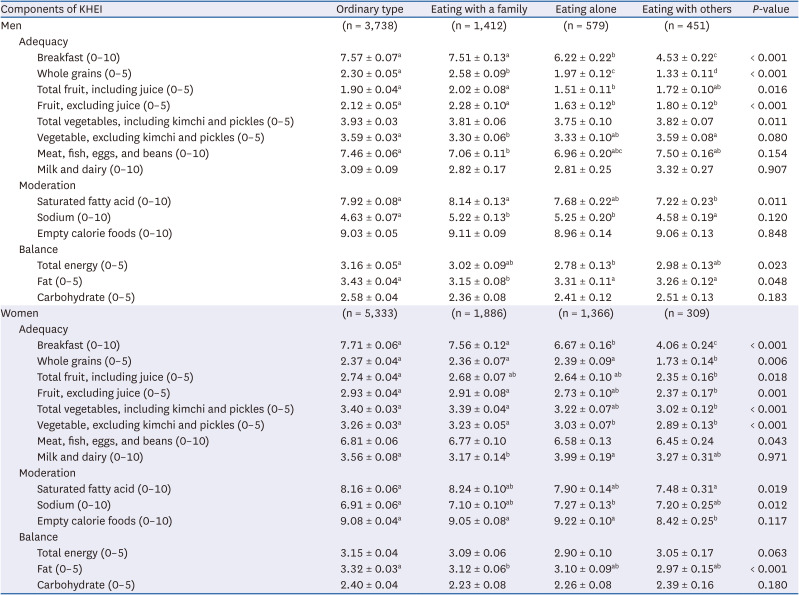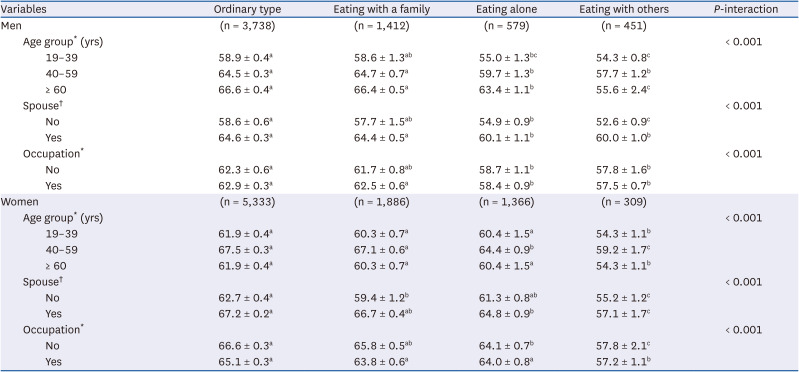1. LaCaille L. Eating behavior. Gellman MD, Turner JR, editors. Encyclopedia of Behavioral Medicine. New York (NY): Springer New York;2013. p. 641–642.
2. Fulkerson JA, Larson N, Horning M, Neumark-Sztainer D. A review of associations between family or shared meal frequency and dietary and weight status outcomes across the lifespan. J Nutr Educ Behav. 2014; 46:2–19. PMID:
24054888.
3. do Amaral E Melo GR, Silva PO, Nakabayashi J, Bandeira MV, Toral N, Monteiro R. Family meal frequency and its association with food consumption and nutritional status in adolescents: a systematic review. PLoS One. 2020; 15:e0239274. PMID:
32946506.
4. Woodruff SJ, Hanning RM, McGoldrick K, Brown KS. Healthy eating index-C is positively associated with family dinner frequency among students in grades 6-8 from Southern Ontario, Canada. Eur J Clin Nutr. 2010; 64:454–460. PMID:
20197788.
5. Neumark-Sztainer D. Eating among teens: do family mealtimes make a difference for adolescents’ nutrition? New Dir Child Adolesc Dev. 2006; 2006:91–105.
6. Befort C, Kaur H, Nollen N, Sullivan DK, Nazir N, Choi WS, Hornberger L, Ahluwalia JS. Fruit, vegetable, and fat intake among non-Hispanic black and non-Hispanic white adolescents: associations with home availability and food consumption settings. J Am Diet Assoc. 2006; 106:367–373. PMID:
16503225.
7. Woodruff SJ, Hanning RM. A review of family meal influence on adolescents’ dietary intake. Can J Diet Pract Res. 2008; 69:14–22. PMID:
18334049.
8. Woodruff SJ, Hanning RM. Associations between family dinner frequency and specific food behaviors among grade six, seven, and eight students from Ontario and Nova Scotia. J Adolesc Health. 2009; 44:431–436. PMID:
19380089.
9. Burgess-Champoux TL, Larson N, Neumark-Sztainer D, Hannan PJ, Story M. Are family meal patterns associated with overall diet quality during the transition from early to middle adolescence? J Nutr Educ Behav. 2009; 41:79–86. PMID:
19304252.
10. Welsh EM, French SA, Wall M. Examining the relationship between family meal frequency and individual dietary intake: does family cohesion play a role? J Nutr Educ Behav. 2011; 43:229–235. PMID:
21536496.
11. Woodruff SJ, Campbell K, Campbell T, Cole M. The associations of meals and snacks on family meals among a sample of grade 7 students from Southwestern Ontario. Appetite. 2014; 82:61–66. PMID:
25038406.
12. Koszewski W, Behrends D, Nichols M, Sehi N, Jones G. Patterns of family meals and food and nutrition intake in limited resource families. Fam Consum Sci Res J. 2011; 39:431–441.
13. Pachucki MC, Karter AJ, Adler NE, Moffet HH, Warton EM, Schillinger D, O’Connell BH, Laraia B. Eating with others and meal location are differentially associated with nutrient intake by sex: the Diabetes Study of Northern California (DISTANCE). Appetite. 2018; 127:203–213. PMID:
29601920.
14. Larson N, Laska MN, Story M, Neumark-Sztainer D. Predictors of fruit and vegetable intake in young adulthood. J Acad Nutr Diet. 2012; 112:1216–1222. PMID:
22698924.
15. Berge JM, MacLehose RF, Loth KA, Eisenberg ME, Fulkerson JA, Neumark-Sztainer D. Family meals. Associations with weight and eating behaviors among mothers and fathers. Appetite. 2012; 58:1128–1135. PMID:
22425759.
16. Lee EJ, Lee KR, Kim JY. Analysis of differences in eating alone attitude of Koreans by dietary habits and age. Appetite. 2020; 152:104695. PMID:
32246954.
17. Bloom I, Edwards M, Jameson KA, Syddall HE, Dennison E, Gale CR, Baird J, Cooper C, Aihie Sayer A, Robinson S. Influences on diet quality in older age: the importance of social factors. Age Ageing. 2017; 46:277–283. PMID:
27744301.
18. Vesnaver E, Keller HH, Sutherland O, Maitland SB, Locher JL. Alone at the table: food behavior and the loss of commensality in widowhood. J Gerontol B Psychol Sci Soc Sci. 2016; 71:1059–1069. PMID:
26556790.
19. Shikany JM, Manson JE, Shadyab AH, Garcia L, Lewis CE, Neuhouser ML, Tinker LF, Beasley JM, Beresford SA, Zaslavsky O, et al. Associations of social, physical, and financial factors with diet quality among older, community-dwelling women. Menopause. 2020; 27:756–762. PMID:
32132442.
20. Sobal J, Nelson MK. Commensal eating patterns: a community study. Appetite. 2003; 41:181–190. PMID:
14550316.
21. Mötteli S, Siegrist M, Keller C. Women’s social eating environment and its associations with dietary behavior and weight management. Appetite. 2017; 110:86–93. PMID:
27986538.
22. Korea Centers for Disease Control and Prevention. Guidelines for the use of 6th (2013-2015) Korea National Health and Nutrition Examination Survey raw data 2017 [Internet]. Cheongju: Korea Centers for Disease Control and Prevention;2018. Available from:
https://knhanes.kdca.go.kr/knhanes/sub03/sub03_06_mod.do.
23. Kweon S, Kim Y, Jang MJ, Kim Y, Kim K, Choi S, Chun C, Khang YH, Oh K. Data resource profile: the Korea National Health and Nutrition Examination Survey (KNHANES). Int J Epidemiol. 2014; 43:69–77. PMID:
24585853.
24. Yun S, Shim JS, Kweon S, Oh K. Development of a food frequency questionnaire for the Korea National Health and Nutrition Examination Survey: data from the Fourth Korea National Health and Nutrition Examination Survey (KNHANES IV). Korean J Nutr. 2013; 46:186–196.
25. Yook SM, Park SH, Moon HK, Kim K, Shim J, Hwang JY. Development of Korean Healthy Eating Index for adults using the Korea National Health and Nutrition Examination Survey data. J Nutr Health. 2015; 48:419–429.
26. Yoon YS, Oh SW. Relationship between psychological distress and the adherence to the Korean healthy eating index (KHEI): the Korea National Health and Nutrition Examination Survey (KNHANES) 2013 and 2015. Nutr Res Pract. 2021; 15:516–527. PMID:
34349884.
27. Lee J, Lee C, Min J, Kang DW, Kim JY, Yang HI, et al. Development of the Korean Global Physical Activity Questionnaire: reliability and validity study. Glob Health Promot Educ. 2020; 27:44–55.
28. Kim Y. The Korea National Health and Nutrition Examination Survey (KNHANES): current status and challenges. Epidemiol Health. 2014; 36:e2014002. PMID:
24839580.
29. Huang YC, Cheng HL, Wahlqvist ML, Lo YC, Lee MS. Gender differences in longevity in free-living older adults who eat-with-others: a prospective study in Taiwan. BMJ Open. 2017; 7:e016575.
30. Kurotani K, Ishikawa-Takata K, Takimoto H. Diet quality of Japanese adults with respect to age, sex, and income level in the National Health and Nutrition Survey, Japan. Public Health Nutr. 2020; 23:821–832. PMID:
31736456.
31. Hendrie GA, Lyle G, Mauch CE, Haddad J, Golley RK. Understanding the variation within a dietary guideline index score to identify the priority food group targets for improving diet quality across population subgroups. Int J Environ Res Public Health. 2021; 18:378. PMID:
33418998.
32. Livingstone KM, Pnosamy H, Riddell LJ, Cicerale S. Demographic, behavioural and anthropometric correlates of food liking: a cross-sectional analysis of young adults. Nutrients. 2020; 12:3078. PMID:
33050309.
33. Thorpe MG, Kestin M, Riddell LJ, Keast RS, McNaughton SA. Diet quality in young adults and its association with food-related behaviours. Public Health Nutr. 2014; 17:1767–1775. PMID:
23866858.
34. Doherty AM, Lacko AM, Popkin BM. Sugar-sweetened beverage (SSB) consumption is associated with lower quality of the non-SSB diet in US adolescents and young adults. Am J Clin Nutr. 2021; 113:657–664. PMID:
33381808.
35. Ruddock HK, Brunstrom JM, Vartanian LR, Higgs S. A systematic review and meta-analysis of the social facilitation of eating. Am J Clin Nutr. 2019; 110:842–861. PMID:
31435639.
36. Kimura Y, Wada T, Okumiya K, Ishimoto Y, Fukutomi E, Kasahara Y, Chen W, Sakamoto R, Fujisawa M, Otsuka K, et al. Eating alone among community-dwelling Japanese elderly: association with depression and food diversity. J Nutr Health Aging. 2012; 16:728–731. PMID:
23076516.
37. Kwon AR, Yoon YS, Min KP, Lee YK, Jeon JH. Eating alone and metabolic syndrome: a population-based Korean National Health and Nutrition Examination Survey 2013-2014. Obes Res Clin Pract. 2018; 12:146–157. PMID:
29066025.
38. Rha JY, Lee B, Nam Y, Yoon J. COVID-19 and changes in Korean consumers' dietary attitudes and behaviors. Nutr Res Pract. 2021; 15:S94–109. PMID:
34909136.








 PDF
PDF Citation
Citation Print
Print



 XML Download
XML Download